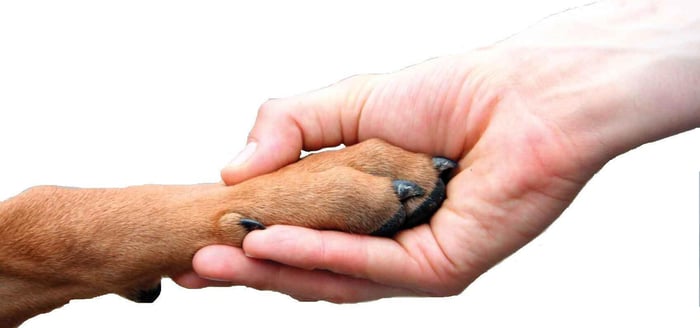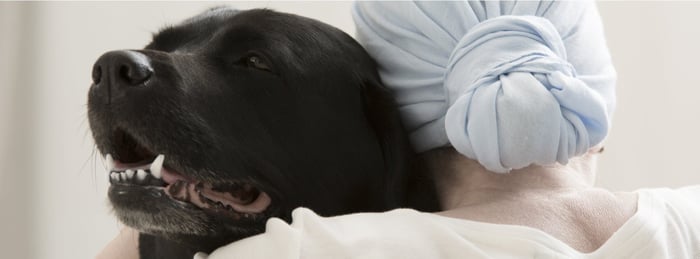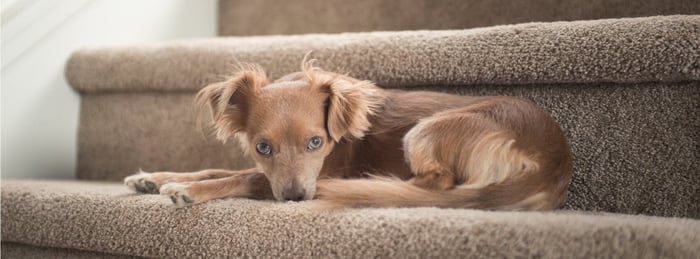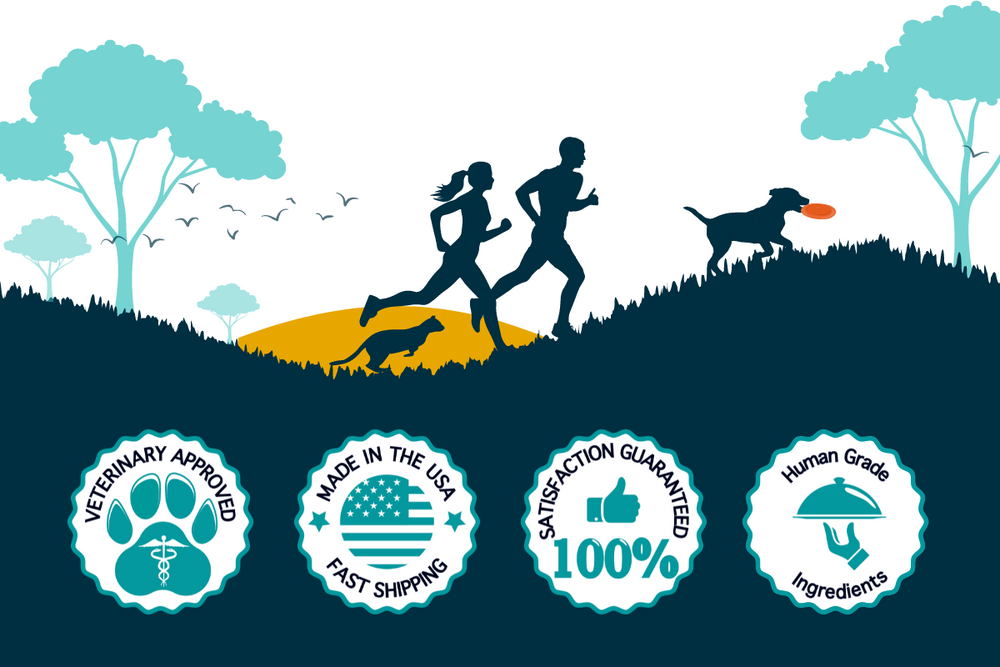What Are Dewclaws?
The dewclaw, also called the first digit, can be found on the inner (medial) side of the front (and sometimes back) legs above the weight-bearing joints. Dewclaws contain two bones: a proximal phalanx and a distal phalanx (similar to the structure of the human thumb). The dewclaws contain a blood supply and therefore can get infected.
 Source: Evans H., and de Lahunta, A. (2013). Miller’s Anatomy of the Dog. Louis: Elsevier, 2013.
Source: Evans H., and de Lahunta, A. (2013). Miller’s Anatomy of the Dog. Louis: Elsevier, 2013.Front Limb Dewclaws
- Five tendons attach to the dewclaw and play an important role when the dog is in motion
- Front dewclaws tend to “wiggle” less than hind limb dewclaws, as they are attached by tendons
- When a dog’s lead leg is on the ground during the gallop or canter, the dewclaw is on the ground to stabilize the carpus
- When a dog turns, the dewclaw digs into the ground to support the structures of the lower limb and prevent torque
- When a dog is traveling at fast speeds (e.g., running, performing agility, chasing a squirrel or other dog) or running on a slippery surface, these dewclaws help provide additional traction to stabilize the lower carpus joint
- Some dogs will use their dewclaws to hold objects (e.g., bones) or use them to climb out of water (e.g., if they’ve broken through ice)
- Front dewclaws are not functional in the standing position
- These five tendons could atrophy if the dewclaw were removed AND can cause excessive torque and rotation at the carpal joint
Hind Limb Dewclaws
- Some breeds have fully developed first digits of the hind limb, but typically hind limb dewclaws are only attached by the skin (which makes them more mobile) on the medial surface of the tarsus
- Occasionally, two claws of equal size are present on the medial side of the tarsus, which is known as the double dewclaw (e.g., St. Bernard), but this is less common
- The hind dewclaws do not have associated tendons and are considered nonfunctional (though they may be required for some breed standards)
- Examples of breeds that must have the dewclaw present in order to be recognized as the breed standard include Great Pyrenees, St. Bernard, Briard, Icelandic Sheepdog
Confused about which digit is which?
Digits – Which digit is which?  Digit 1 = Dewclaw. They serve to stabilize the carpus when turning or running on the ground and prevent excessive torque. Digits 2 through 5 are the primary functional and weight-bearing digits because they make contact with the ground when the dog is standing.
Digit 1 = Dewclaw. They serve to stabilize the carpus when turning or running on the ground and prevent excessive torque. Digits 2 through 5 are the primary functional and weight-bearing digits because they make contact with the ground when the dog is standing.
Digits 3 and 4 are located centrally and are considered the most important given their location and because they are longer than the other digits.
Why do people remove dewclaws?
There is much debate on social media regarding the importance and function of the dewclaw.
So much, in fact, that more than 1.2 million people have viewed my initial post on dewclaws with varying opinions and suggestions about the utility, injury rate, and necessity of this digit.
Front and hindlimb dewclaws are typically removed by some at 3-5 days of age, as they are believed to be a nonfunctional digit that a) poses an unnecessary risk for being injured and b) increases the chances of developing an infection.
In some breeds of dogs, front limb dewclaws are routinely removed to improve the dog’s front-end appearance in the show ring. In standing, the front dewclaw may not appear to be functional because it doesn't come in contact with the ground.
However, observing the dewclaw when the dog is in motion tells a different story. In some cases, a dog’s front dewclaw is removed if it has been severely injured or has developed a disease (e.g., cancerous tumor).
In these cases, it is certainly in the dog’s best interest to remove it. In speaking with numerous veterinarians, it has been found that dewclaws are the least injured digit of the canine carpus! Hindlimbb dewclaws tend to be removed more frequently because they are loosely attached by skin and pose more of a risk of getting caught on something or ripped.
Is my dog at greater risk of injury if they don’t have their front dewclaws?
YES! If a dog does not have front dewclaws, there is a higher potential for the carpal ligaments to stretch and tear, which could result in laxity and arthritis over time (OUCH!).
This can then result in more stress being generated through the dog's carpus, elbow, shoulder, and spine as it tries to compensate for the lack of digit. In speaking with many vets, you would be surprised at how few dewclaw injuries they see.
A recent retrospective internet-based study was completed to determine the potential risk factors for digit injuries in dogs training and competing in the sport of agility.
Data was collected via an extensive internet-based survey including 207 dogs with and 874 dogs without digit injuries. This study found that dewclaws were the least commonly injured digit (occurring in 7.3% of dogs that had dewclaws).
Dogs had a higher chance of developing a digit injury if they had long nails (2.4x) or if they didn’t have a dewclaw (1.9x).
This study suggests that having well-trimmed dewclaws could potentially minimize your dog’s chance of a digit injury.
Although this is a study focusing on a canine sport, many of the movements seen in the sport of agility could easily be translated and seen in one’s backyard.
Think of your dog chasing a rabbit or bird whether in your backyard or on a hike—OR when your dog leaps and bounds through a forest, running over trees and brushes and making sudden turns.
In these situations, your dog is turning at a high speed, and without a dewclaw they could be increasing their chances of injuring their front limbs.
In dogs, the most common injuries seen by many rehab providers and vets occur in the shoulder complex, yet we don’t see shoulders being removed. Food for thought!
How can I prevent an injury to a dewclaw?
Keep it trim! The dewclaw is no different than any other nail and therefore should be trimmed and cared for like all other nails. Due to the positioning of the dewclaw (higher up on the dog’s leg), it has no way of being worn down naturally.
Therefore, these dewclaws may even have to be trimmed more often than other nails. If left untrimmed, it can curve down and become ingrown, which could put the dog at risk for an infection. Dewclaws that are too long can make it easier for the dog to catch one running in a field while working or playing, which can result in a torn toe.
So what should I do?
The front dewclaw is not just the remains of a digit that has regressed in the course of evolution. There are five tendons attached to the dewclaw that could potentially atrophy if the dewclaw were to be removed.
It has a necessary function in our performance dogs but ALSO in our pet dogs who frequently chase squirrels in the backyard or run off leash for hikes. Maintaining your dog’s dewclaws is important to ensure they don’t grow too long, which could increase the chances of them catching and tearing.
Like this blog? Want to learn more about Carolyn McIntyre, PT? Check her out on FB or Instagram! Sellon, D., et al. (2018). A survey of risk factors for digit injuries among dogs training and competing in agility events. J Am Vet Med Assoc; 252(1):75–83. Zink, M. Christine. "Do the Dew(claws)?." Canine Sports Productions. http://www.caninesports.com/DewClawExplanation.pdf (accessed May 25, 2012).









